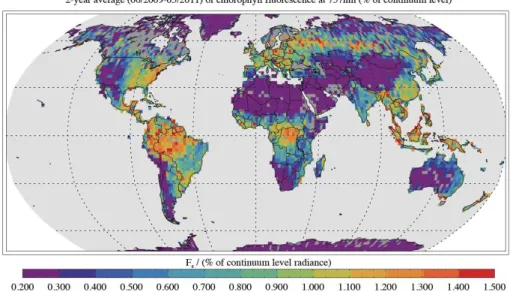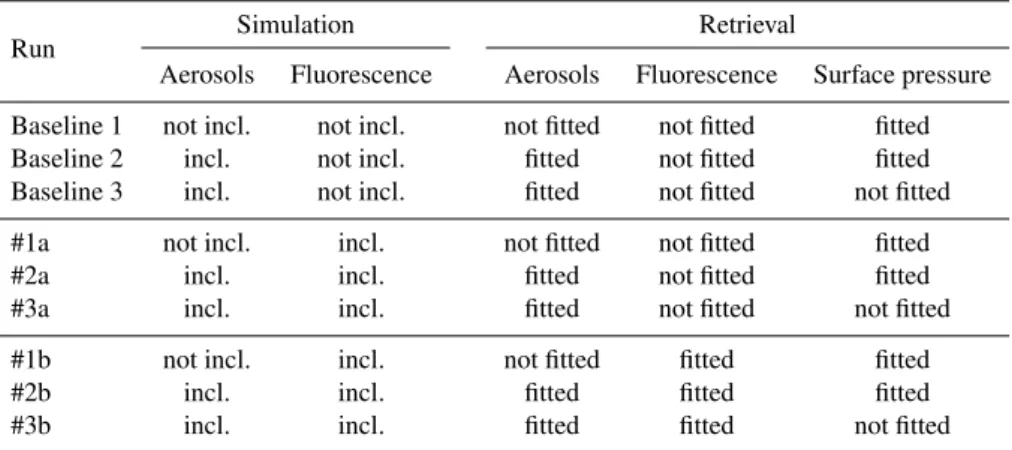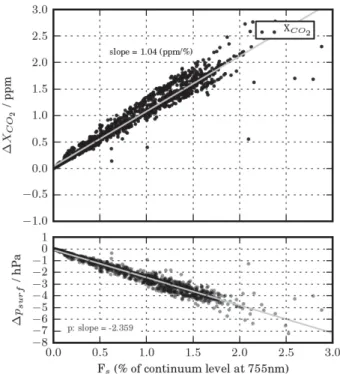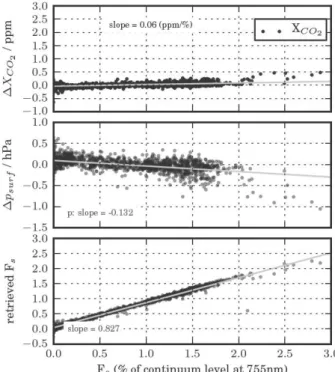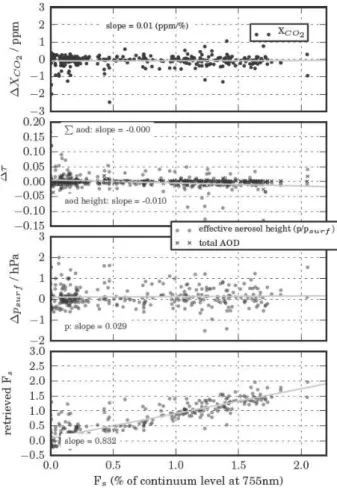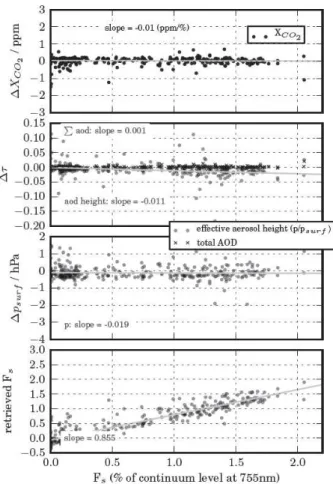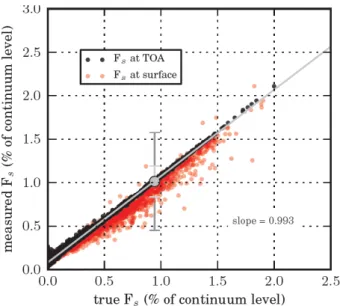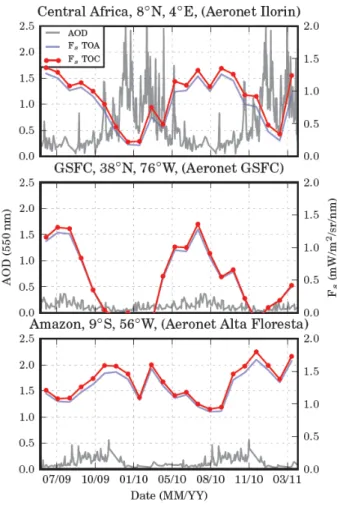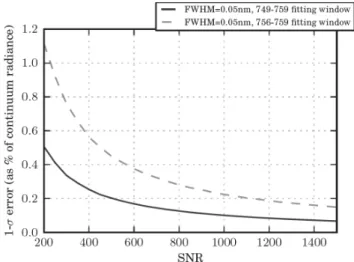www.atmos-meas-tech.net/5/2081/2012/ doi:10.5194/amt-5-2081-2012
© Author(s) 2012. CC Attribution 3.0 License.
Measurement
Techniques
Remote sensing of near-infrared chlorophyll fluorescence from
space in scattering atmospheres: implications for its retrieval and
interferences with atmospheric CO
2
retrievals
C. Frankenberg1, C. O’Dell2, L. Guanter3, and J. McDuffie1
1Jet Propulsion Laboratory, California Institute of Technology, Pasadena, USA 2Colorado State University, Fort Collins, CO, USA
3Atmospheric, Oceanic and Planetary Physics, University of Oxford, UK
Correspondence to:C. Frankenberg (christian.frankenberg@jpl.nasa.gov)
Received: 24 February 2012 – Published in Atmos. Meas. Tech. Discuss.: 29 March 2012 Revised: 12 June 2012 – Accepted: 20 July 2012 – Published: 28 August 2012
Abstract. With the advent of dedicated greenhouse gas space-borne spectrometers sporting high resolution spectra in the O2A-band spectral region (755–774 nm), the retrieval of chlorophyll fluorescence has become feasible on a global scale. If unaccounted for, however, fluorescence can indi-rectly perturb the greenhouse gas retrievals as it perturbs the oxygen absorption features. As atmospheric CO2 measure-ments are used to invert net fluxes at the land–atmosphere interface, a bias caused by fluorescence can be crucial as it will spatially correlate with the fluxes to be inverted. Avoid-ing a bias and retrievAvoid-ing fluorescence accurately will provide additional constraints on both the net and gross fluxes in the global carbon cycle. We show that chlorophyll fluorescence, if neglected, systematically interferes withfull-physics multi-bandXCO2retrievals using the O2A-band. Systematic biases inXCO2 can amount to +1 ppm if fluorescence constitutes 1 % to the continuum level radiance. We show that this bias can be largely eliminated by simultaneously fitting fluores-cence in a full-physics based retrieval.
If fluorescence is the primary target, a dedicated but very simple retrieval based purely on Fraunhofer lines is shown to be more accurate and very robust even in the presence of large scattering optical depths. We find that about 80 % of the surface fluorescence is retained at the top-of-atmosphere, even for cloud optical thicknesses around 2–5. We further show that small instrument modifications to future O2 A-band spectrometer spectral ranges can result in largely re-duced random errors in chlorophyll fluorescence, paving the way towards a more dedicated instrument exploiting solar ab-sorption features only.
1 Introduction
Both the Greenhouse Gases Observing Satellite (GOSAT) (Hamazaki et al., 2005; Kuze et al., 2009) and the Orbiting Carbon Observatory (OCO) (Crisp et al., 2004) aim at re-trieving atmospheric greenhouse gas column averaged mix-ing ratios (denotedXCO2 orXCH4) with high enough accu-racy and precision to improve our current understanding of land–atmosphere fluxes on regional scales. OCO, targeting CO2exclusively, suffered a launch failure in early 2009, but an instrument copy is being built and the launch of OCO-2 is planned for 2014.
The termfull-physicsalgorithm is commonly used in the atmospheric remote sensing community for retrievals based on the full modeling of the radiative transfer instead of parameterizations or a decoupling of the retrieval of trace gas slant column densities and radiative transfer modeling. A typical full-physics algorithm for the retrieval of XCO2 (B¨osch et al., 2006; Butz et al., 2009; O’Dell et al., 2011) concurrently employs three spectral bands, centered around 0.76 µm (O2A-band), 1.61 µm (weak CO2band) and 2.06 µm (strong CO2 band). By using this multi-channel approach,
be unambiguously distinguished from the effect of scattering on the depth and shape of atmospheric O2absorption features in the 0.76 µm range. However, the potential propagated im-pact onXCO2 retrievals was not explicitly quantified.
The goals of this paper are twofold: first, to quantify and mitigate the potential impact of chlorophyll fluorescence on
XCO2retrievals, and second, to quantify how accurately TOA (top-of-atmosphere) fluorescence can be retrieved and how it relates to fluorescence at the surface level. While the first goal is of a technical nature and relates to the CO2 remote sensing community, the second one has implications regard-ing the applicability of remotely sensed chlorophyll fluores-cence, especially given that real retrievals are now being suc-cessfully performed using GOSAT data (Joiner et al., 2011; Frankenberg et al., 2011b; Guanter et al., 2012; Joiner et al., 2012).
The paper is structured as follows: Sect. 2 gives an overview of the chlorophyll fluorescence signal and its ap-plication in plant physiology and vegetation remote sensing. Section 3 describes the implementation of the fluorescence emission in a radiative transfer model for simulations as well as in a full-physics retrieval algorithm. Section 4 shows sim-ulation results as to how fluorescence impacts scattering and
XCO2 retrievals. Section 5 focuses on the retrieval of the chlorophyll fluorescence signal itself and discusses howFs retrieved at TOA relates to the emission from the plant at surface level in the presence of scattering. It also provides an overview on how future satellites with similar measure-ment principles can improve upon current and planned ones. The audience for this manuscript may be rather diverse, with interest either inXCO2 or fluorescence retrievals. Thus, we tried to keep Sect. 4 (focused onXCO2 biases) and Sect. 5 (focused on chlorophyll fluorescence itself) as self-contained as possible in case the general reader wants to skip sections.
2 Chlorophyll fluorescence
Shortwave energy obtained from a laser or a visible light pulse with laboratory or field instruments, or by the sun, is collected within vegetation by chlorophyll. Under optimal conditions, most of this energy is routed through photosyn-thesis, but typically some energy is dissipated as heat or re-emitted via fluorescence at longer wavelengths in the 660– 800 nm window. When determined under natural conditions outdoors, the fluorescence obtained is referred to as solar-induced chlorophyll fluorescence (Krause and Weis, 1991; Baker, 2008, and references therein). Fluorescence intensity is thus an indicator of photosynthetic activity. At the surface level, the fluorescence emission (Fs) adds a small offset of up to about 10 W m−2sr−1µm−1(Entcheva Campbell et al., 2008) in the two emission peaks around 690 and 740 nm, the latter of which encompasses the strong O2 A-band around 765 nm. The broad-band emission leads to a filling-in of solar and telluric absorption features (Plascyk and Gabriel, 1975),
and current retrieval techniques at the ground and airborne scales mostly focus on using the O2absorption features for its retrieval. See Meroni et al. (2009) for a literature overview of common retrieval techniques for fluorescence signals used to study the photosynthetic apparatus (e.g., Krause and Weis, 1984, 1991; Flexas et al., 2002; Moya et al., 2004; Rascher et al., 2009) and stress related changes in gross primary pro-duction (GPP) (Damm et al., 2010; Daumard et al., 2010). However, there are still uncertainties regarding the contribu-tion of Photosystem I (PSI, Pfuendel, 1998) to the chloro-phyll fluorescence signal in the 755–770 nm window under natural and stressed conditions. The primary driver of fluo-rescence is certainly absorbed photosynthetically active ra-diation, but the inter-play between photosynthesis and fluo-rescence yield in steady-state conditions may require further research before fluorescence modeling (Van der Tol et al., 2009) offers a consolidated physiology-based link between NIR fluorescence and photosynthetic efficiency. A good cor-relation of space-based fluorescence retrievals with gross pri-mary production on the coarser regional scale, however, was demonstrated in Frankenberg et al. (2011b) and Guanter et al. (2012).
In Frankenberg et al. (2011a), we have shown that the use of O2 lines in fluorescence retrievals cannot be readily ap-plied if only the O2 A-band is measured and a ground ref-erence value is unavailable. However, Fraunhofer lines (ab-sorption features in the solar atmosphere) can be used to dis-entangle the fluorescence emission from scattering effects, a technique used in the quantification of chlorophyll emis-sion from GOSAT data (Joiner et al., 2011, 2012; Franken-berg et al., 2011b).
To put the analysis in the following sections into perspec-tive, Fig. 1 shows a 2-yr average of chlorophyll fluorescence in terms of percent of continuum level radiance. Regional av-erages can reach 1.5 % with sharp gradients occurring at tran-sitions to barren surfaces. Systematic biases caused by the neglect of fluorescence in space-based retrievals ofXCO2will thus resemble these regional-scale spatial structures, which, in turn, are related to GPP.
3 Fluorescence implementation in simulations and retrievals
Fig. 1.2-yr average of retrieved chlorophyll fluorescence at 757 nm, retrieved and corrected according to Frankenberg et al. (2011b).
3.1 Accurate implementation in a radiative transfer scheme for simulation purposes
In order to provide realistic simulations of the O2 A-band at TOA impacted by fluorescence, we implemented the hith-erto neglected chlorophyll emission into the satellite simula-tor used for GOSAT and OCO-2 studies (O’Dell et al., 2011). The simulator models spectra at the TOA using realistic and diverse aerosol and cloud distributions, surface and instru-ment properties, coupled with an accurate radiative transfer model (O’Brien et al., 2009). The main purpose of the sim-ulator is to quantify systematic errors in retrievedXCO2, as the retrieval approach cannot capture the full variability of atmospheric and surface properties, most importantly clouds and aerosols.
For the sake of simplicity, we model fluorescence as an isotropic, unpolarized source term at the surface. The spectral shape of the surface emission, given for instance in Guanter et al. (2010), is modeled as two co-added Gaussians:
Fs(λ)=Fs,755·
A1e
−(λ−λ1)2 2σ12 +A
2e
−(λ−λ2)2 2σ22
, (1)
whereFs,755is the fluorescence intensity at 755 nm. The pa-rameters in Eq. (1) are given in Table 1.
This model has the benefit that it enables future studies using other wavelength regions and that the spectral shape in the A-band is fairly realistic. This allows for the assess-ment of errors due to the assumption of linearity used in the retrieval described in Sect. 3.2.
The fluorescence emission from the surface has to pass through the atmosphere to be detected by the satellite at TOA. It will undergo absorption by gases, Rayleigh scatter-ing, as well as possible extinction by clouds and aerosols.
These effects are accurately modeled using a 24-stream adding-doubling radiative transfer model (see, e.g., Liou, 2002). In this radiative transfer approach, global scalar re-flectance and transmittance matrices are derived for the entire atmosphere using doubling for individual layers, and adding in order to combine all the atmospheric layers together. The surface emission at TOA is modeled as:
FTOA=Ta(I−RgRa)−1Fsurf, (2) whereTa(Ra)is the atmospheric transmittance (reflectance) matrix from surface to space, Rg is the surface reflectance matrix, Fsurf is the isotropic fluorescence emission vec-tor at the surface, and FTOA is the corresponding vector at TOA. Polarization effects of the atmosphere on the un-polarized fluorescence emission are assumed to be small. As for the scattered solar irradiance, the method of “low-streams interpolation” (O’Dell, 2010) is used to accelerate the radiative transfer.
The spatial distribution of Fs in the simulator is based upon 0.5◦×0.5◦GPP distribution from Beer et al. (2010) and the empirical linear relationship betweenFsand GPP derived in Frankenberg et al. (2011b). For the following analysis, we simulated three polar orbits of a GOSAT-like instrument in nadir viewing geometry. This is a subset of the orbits used in a recent simulation-based study of satellite-basedXCO2 re-trievals (O’Dell et al., 2011).
Table 1.Parameters of the fluorescence spectral shape model used in simulations.
Gaussian A(W m−2µm−1sr−1) λ(nm) σ(nm)
1 1.445 736.8 21.2
2 0.868 685.2 9.55
3.2 Simplified implementation for retrieval purposes
A typicalXCO2 full-physics retrieval algorithm uses a radia-tive transfer model to simulate radiances at TOA as a func-tion of atmospheric parameters such as surface albedo as well as absorption and scattering profiles (including scatter-ing phase functions). The Jacobians of the simulated radi-ances are computed with respect to retrieval parameters such as the CO2profile, surface albedo, as well as aerosol optical depth (AOD) and profile. Given a true set of radiances mea-sured by a space-borne spectrometer, the retrieval parame-ters can be inverted using a non-linear least squares approach minimizing the differences between modeled and measured radiances. The most common setup makes concurrent use of three bands in a combined retrieval: the O2A-band at 760 nm as well as weak and strong CO2bands at 1.6 and 2 µm, re-spectively. Chlorophyll fluorescence, if neglected, will im-pact the radiances in one of the retrieval windows, viz. the O2A-band.
We now describe modifications to the standard ACOS/OCO-2 (ACOS = Atmospheric Carbon Observa-tions from Space) XCO2 retrieval algorithm to include chlorophyll fluorescence. This algorithm has been described at length in O’Dell et al. (2011) and references therein. Briefly, this optimal estimation-based algorithm (Rodgers, 2000) attempts to minimize differences between observed and modeled spectra in the three spectral bands described above, moderated by a side constraint involving prior knowl-edge. The algorithm fits simultaneously for a profile of CO2, surface pressure, a linearly-varying surface albedo in each of the three fitted bands, spectral wavelength offset in each band, and profiles of four scattering particle types with fixed microphysical and optical properties. These include a water cloud type, an ice cloud type, and two different aerosol types. The idea is that by mixing together these different types appropriately, virtually any type of scattering situation can be modeled. When applied to actual GOSAT data, it was found that an additional state vector parameter representing a zero-level offset in the O2 A-band was also needed to correct for an instrument calibration problem (Crisp et al., 2012; Butz et al., 2011).
We implemented the chlorophyll fluorescence emission as two additional state vector elements in the ACOS re-trieval algorithm, as follows. We simplify the simulation of the chlorophyll emission inside the retrieval forward model by decoupling it entirely from the radiative transfer mode.
Instead of calculating the full scattering effect on the chloro-phyll emission observed at TOA, we solely model the spec-tral shape as well as the absorption features by O2. The flu-orescence is then treated as a simple additive term to the ra-diance calculated by the radiative transfer code before con-volution with the instrument line shape is performed. The fluorescence term at the surface (using nm asλunits) in the retrieval is:
Fs(λ)surf=Fssurf,755·(1−s(λ−755)) , (3)
where the two state vector elements Fs,755 ands represent the chlorophyll emission at 755 nm and its spectral slope, re-spectively. Compared to a simpler polynomial representation ofFs(λ)surf, this parameterization allows a scaling of a pre-defined spectral shape with some freedom for adjusting the slope itself. This model explicitly assumes a linear spectral shape over the relatively narrow O2A-band, an assumption that is not made in theFssimulation (Sect. 3.1).
At TOA, the modeled fluorescence ignoring scattering reads:
Fs(λ)TOA≈Fs(λ)surf·e−τO2(λ)/µ, (4) whereµ represents the cosine of the viewing zenith angle andτO2(λ)the vertical optical thickness of O2.Fs(λ)
TOAis simply added to the radiative transfer scheme implemented in the ACOS/OCO-2 full-physics retrieval algorithm, largely facilitating the calculation of Jacobians with respect toFs,755 and s.
4 Interference errors between scattering properties,
XCO2 and chlorophyll fluorescence
The impact of chlorophyll fluorescence on the retrieval of
XCO2 is rather complex, as it is propagated through its in-terference with retrieved scattering properties and, poten-tially, surface pressure. The impact can vary not only scene-by-scene but also between different retrieval algorithms, de-pending on how scattering and surface pressure are treated. However, there always is a propagation of biases from the O2 A-band intoXCO2, unless the retrieval is set up to entirely de-couple the O2A-band from the CO2retrieval, which would forfeit the initial purpose of the O2A-band in CO2retrievals. In this study, we focus on the ACOS/OCO-2 3-band retrieval algorithm described above.
Table 2.Simulation and retrieval setups used in the sensitivity studies. Baseline runs are the benchmark for business as usual (fluorescence neither simulated nor retrieved), runs #xa have fluorescence in the simulation but ignore them in the retrieval, and runs #xb attempt to fit fluorescence in the retrieval as well.
Run Simulation Retrieval
Aerosols Fluorescence Aerosols Fluorescence Surface pressure
Baseline 1 not incl. not incl. not fitted not fitted fitted Baseline 2 incl. not incl. fitted not fitted fitted Baseline 3 incl. not incl. fitted not fitted not fitted
#1a not incl. incl. not fitted not fitted fitted #2a incl. incl. fitted not fitted fitted #3a incl. incl. fitted not fitted not fitted
#1b not incl. incl. not fitted fitted fitted
#2b incl. incl. fitted fitted fitted
#3b incl. incl. fitted fitted not fitted
quantify systematic biases, we run all retrievals twice: once using simulations with no fluorescence added and once with fluorescence included. In the following, all biases caused by fluorescence are reported as the difference between the two runs. Both runs are performed using noise-less simulations, while a realistic GOSAT-like noise is assumed in the mea-surement error covariance matrix for the retrieval.
4.1 Case I: ignoring fluorescence
As stated previously, most retrieval algorithms of CO2which employ the O2A-band currently entirely ignore chlorophyll fluorescence. They will thus be subject to systematic biases depending on their specific retrieval setup as well as instru-ment characteristics, most importantly spectral resolution. Here and in the following, we focus on simulations per-formed for GOSAT spectral resolution. Contrary to SCIA-MACHY, for instance, Fraunhofer lines can be better re-solved and will thus reduce interference errors.
4.1.1 Aerosol-free atmosphere
In the absence of aerosol scattering in the atmosphere, chlorophyll fluorescence nevertheless impacts the retrieval of
XCO2, as the reduction in fractional depth of O2absorption lines can resemble a change in surface pressure. Case #1a represents this most simple case, viz. a completely aerosol free atmosphere assumed in both simulations and retrievals. The only free variables in the retrieval related to the O2 A-band are thus spectral albedo, spectral shift, temperature off-set and surface pressure (given a 4 hPa 1-σprior uncertainty). AsFs fills in the O2lines, surface pressure is consequently underestimated with increasingFs.
Figure 3 shows the errors propagating into CO2 via the negative surface pressure bias with increasing fluorescence. At about 1 % relativeFs, the overestimation inXCO2amounts to 1 ppm. Changes in retrieved surface pressure are about
2.5 hPa, slightly higher than current uncertainties in sur-face pressure from meteorological models (1–2 hPa, Sal-stein et al., 2008). Errors propagated intoXCO2 are, in this case, entirely caused by biases in the retrieved dry airmass (through surface pressure) needed to calculate the column averaged dry air mole fraction of CO2.
4.1.2 Aerosol-laden atmosphere
In the presence of scattering in the atmosphere (both in sim-ulation and retrieval), the impact onXCO2 is more complex as various fitting parameters for atmospheric aerosols and/or clouds have to be included in the state vector. These param-eters have been shown to interfere with fluorescence as well (Frankenberg et al., 2011a). In a scattering atmosphere, post-processing has to be performed discarding non-converging and bad retrievals according to O’Dell et al. (2011), with a re-trieved AOD threshold of<0.2.
Figure 4 shows results from case #2a, where both aerosols as well as surface pressure are free retrieval parameters. As expected, the results are more mixed, with higher scatter in the XCO2 biases. The overall fluorescence-induced bias in
XCO2 is somewhat lower than in case #1a, mainly because aerosols can now partially account for the fluorescence term. The propagation of aerosols biases is, however, not as direct as in the case of surface pressure, thus explaining the smaller
Fig. 2.Simulated noise-free spectrum with GOSAT spectral resolution. Solar zenith angle=26.35◦; surface albedo≈0.2; aerosol+cloud optical depth=0.46. The fluorescence spectrum at the TOA is modeled once in a pure Rayleigh atmosphere and once including aerosol and cloud scattering of the emission emanating from the surface. Positions of Fraunhofer lines most suitable for fluorescence retrievals in the GOSAT spectral range are indicated by green lines.
Fig. 3. Case #1a: Changes in retrievedXCO2 as well as surface pressure induced by chlorophyll fluorescence if it is ignored in the retrieval step. Both simulation and retrieval use a Rayleigh-only atmosphere.
efficiently shorten the atmospheric light path (note: in our setup, aerosol height is defined as the peak height of a Gaus-sian aerosol profile).
To investigate the isolated impact of aerosols, we per-formed case #3a, where surface pressure is assumed known, an assumption made by some CO2retrievals (e.g., Butz et al., 2011). Figure 5 shows these results, where naturally only aerosols as well asXCO2 change systematically. As the er-ror propagation through surface pressure is eliminated, the bias induced in XCO2 is lower, though still apparent with an average slope of 0.55 ppm per W m−2sr−1µm−1of NIR chlorophyll fluorescence. However, in both case #2a and case #3a, substantial random scatter in retrievedXCO2 and AOD is induced as well. The impact on aerosols is naturally larger when the surface pressure is fixed.
Looking at cases #1a–3a, one can conclude that the ne-glect of fluorescence in our particular retrieval (and instru-ment characteristics) can result in systematic biases of ≈ 0.5−1 ppm per percent fluorescence contribution to the con-tinuum radiance. Biases in retrieved CO2 are thus within ≈1.5 ppm but vary frequently in the spatial domain (see Fig. 1). While these biases are still below 1 % of the CO2 column amount, they exhibit spatial and temporal correla-tions with GPP, which is why they must not be neglected.
4.2 Case II: fitting fluorescence
Fig. 4.Case #2a: Changes in retrievedXCO2, retrieved aerosols as well as surface pressure induced by chlorophyll fluorescence if it is ignored in the retrieval step. Simulations use a complex set of aerosol scenes, and the retrieval employs the ACOS/OCO-2 stan-dard retrieval setup, fitting for aerosols and surface pressure. Ef-fective aerosol height is defined in normalized pressure coordinates (fraction of surface pressure).
and aerosols. As interferences shown in Frankenberg et al. (2011a) point to problems in fitting all variables simultane-ously, we investigate the impact of including fluorescence as a state vector element, as described in Sect. 3.2. This is done from the perspective of reducing systematic biases in
XCO2, rather than to retrieve fluorescence accurately. Sev-eral studies have already fitted fluorescence using GOSAT data (Frankenberg et al., 2011a,b; Joiner et al., 2011, 2012), but these have so far focussed solely on Fraunhofer lines, avoiding telluric O2absorption features. These are typically used in ground-based studies but are, as will be corroborated in the following section, problematic if observed from TOA. In the pure Rayleigh case, where aerosols are present nei-ther in the simulations nor in the retrieval, the fit can vir-tually eliminate the systematic error previously existent in
XCO2. As shown in Fig. 6, the XCO2 bias changes from 1.07 to 0.07 ppm %−1compared to case #1a. Also, fluores-cence is fitted quite accurately, with the caveat that these are noise-free simulations. However, the retrieval is not able to
Fig. 5.Case #3a: Changes in retrievedXCO2 as well as aerosol in-duced by chlorophyll fluorescence if it is ignored in the retrieval step. Identical to case #2a, Fig. 4, with the only difference that sur-face pressure is assumed known in the retrieval, i.e., not fitted.
Fig. 7.Case #2b: Changes in retrievedXCO2 as well as aerosol induced by chlorophyll fluorescence if fluorescence is fitted. Apart from the fluorescence fit, identical to case #2a, Fig. 4.
reproducethe true fluorescence 1:1, potentially because of the neglect of Rayleigh scattering in the retrieval forward modeling of fluorescence.
Results, especially in terms of scatter unrelated to noise, become more complex when aerosols are explicitly included. Figure 7 shows results for case #2b, where aerosols are present in the simulations, and aerosols as well as surface pressure are fitted in the retrieval. The systematic bias in
XCO2as well as surface pressure is not significant and seems to be dominated by a few outliers. However, there is high scatter in the retrieved fluorescence parameter (noting that this is an accuracy, not a precision error as simulations are noise-free). There is also some scatter induced inXCO2, but most deviations are below 1 ppm and appear unsystematic.
Perfect knowledge of surface pressure (#3b, Fig. 8) slightly improves the situation, with a slope of close to 1 in retrieved vs. true fluorescence. However, the scatter in re-trievedFsin case #3b is still very high, but systematic biases inXCO2 as a function of signal level are small. The inclusion of fluorescence as fitting parameters caused some outliers in retrievedXCO2 at low trueFsvalues though.
Fig. 8. Case #3b: Changes in retrievedXCO2 as well as aerosol induced by chlorophyll fluorescence if fluorescence is fitted. Apart from the fluorescence fit, identical to case #3a, Fig. 5.
Fig. 9.Changes in retrievedXCO2 as well as aerosol induced by chlorophyll fluorescence if it is ignored in the retrieval step but zero-level offset fitted. Otherwise, identical to case #2a, Fig. 4.
4.3 Implications for GOSAT retrievals considering the A-band zero-level offset
Frankenberg et al. (2011b) discovered a zero-level offset in GOSAT O2 A-band spectra, which was subsequently con-firmed by an independent analysis of the JAXA GOSAT team. This adds another dimension to the problem for this particular case for a zero-level offset in FTS systems causes a rather flat offset to the true radiance at all wavelengths. For Fraunhofer lines, this effect is thus virtually indistinguishable from a chlorophyll fluorescence signal as both simply add an additive term to the spectrum. Within O2lines, however, the effect is different from fluorescence for it adds a spectrally flat offset as opposed to fluorescence, where the spectrally flat emission at the surface level is partially reabsorbed by O2 absorption along the path to the detector. Hence, both signals have an identical impact in Fraunhofer lines and the contin-uum but differ in O2absorption features.
For previous dedicated fluorescence retrievals using Fraunhofer lines, the zero-level offset contribution was pa-rameterized as a function of average signal level (representa-tive for the zero-path difference readout in FTS systems) and
Fig. 10.Changes in retrievedXCO2 as well as aerosol induced by chlorophyll fluorescence if it is fitted in the retrieval step in addi-tion to a zero-level offset fit (similar to the current ACOS retrievals) (O’Dell et al., 2011). Otherwise, identical to case #2b, Fig. 7.
later subtracted from the retrieved offset in order to isolate the fluorescence term (Frankenberg et al., 2011b; Guanter et al., 2012). Here, we investigate the impact of fluorescence on the full-physics retrieval in view of the apparent zero-level offset. There are two questions to be answered: (a) what is the potential bias induced by fluorescence on current operational CO2 retrievals fitting the zero-level offset but not fluores-cence, and (b) will a simultaneous retrieval of fluorescence and zero-level offset be stable and also minimize biases in
XCO2? For this purpose, we ran two additional tests, where we (a) mimicked the current ACOS operational retrieval by fitting aerosols, surface pressure and zero-level offset but not fluorescence and (b) fitted fluorescence in addition.
Fig. 11.Retrievals ofFsin a scattering atmosphere using the Fraun-hofer line method (Frankenberg et al., 2011a). Points are for true Fs at TOA vs. retrievedFs (black) and trueFs at the surface vs. retrievedFs(red). Small deviations from the 1.0 slope can be ex-plained by small differences in the spectral shift and squeeze as well as the assumed constancy ofFs (Frankenberg et al., 2011a). Error-bars indicate a typical 1-σ precision error for a GOSAT spe-cific retrieval. Dark gray indicates the single measurement noise and light gray the standard error in an average of 10 soundings.
Figure 10 shows case (b) where we fit for both fluores-cence and zero-level offset. The retrieval appears as stable as when zero-level offset is not fitted and also the bias in
XCO2 is diminished. It can be concluded that currentXCO2 retrievals can include both fluorescence and zero-level offset in their retrieval, thereby eliminating the bias through fluo-rescence even in the presence of systematic instrument er-rors. The main reason why the fit can partially disentangle fluorescence from zero-level offset is the strong difference in the impact on deeply saturated O2lines (where zero-level offset has the highest fractional impact but fluorescence is almost entirely reabsorbed in the atmosphere).
5 Chlorophyll fluorescence as primary retrieval target
In the previous section, we largely focussed on the im-pact of fluorescence onXCO2 retrievals. Here, we focus on the implications of atmospheric scattering by clouds and aerosols on the fluorescence retrieval itself. The most appro-priate way to deal with fluorescence is to avoid the inter-ferences altogether by allowing for a processing step using Fraunhofer lines only, as in Frankenberg et al. (2011a). In the following, this method is used for fluorescence retrievals as the primary target.
Fig. 12.Fraction of the surface fluorescence emission observed at 755 nm at the tof-atmosphere (TOA) as a function of total op-tical depth (calculated from the simulated fluorescence signal at TOA propagated through the scattering atmosphere). The dots in-dicate simulated measurements using realistic aerosols and cloud scenarios. The red lines indicate theoretical curves assuming a sim-ple exp(−x/µ·AOD) relationship wherextakes values of 1, 0.5, 0.2, 0.1, 0.05 (curves left to right).
5.1 Implications of scattering on retrieved chlorophyll fluorescence at top-of-atmosphere
We have shown previously (Frankenberg et al., 2011a) that pure retrieval interference errors between fluorescence and scattering properties can be eliminated in the retrieval if only Fraunhofer lines are used. In the retrieval as outlined be-fore and also in the Fraunhofer line focussed retrieval, we ignore atmospheric scattering. Hence, the retrieved fluores-cence signal accurately represents the true signal at TOA (see Fig. 11) but not necessarily the surface emission.
However, scattering impacts the propagation of the flu-orescence emission from the surface to TOA, hence TOA fluorescence does not necessarily represent fluorescence at the plant level. Given an extinction optical thickness ofτ, which includes gas absorption, Rayleigh scattering and ex-tinction by clouds and aerosols, the direct beam fluorescence would be reduced bye−τ/µ. However, the fluorescence signal is partially conserved in the diffuse radiation field. This es-sentially smears out the effective FOV representative for the
Fs signal at TOA, which should be negligible for footprint sizes on the order of multiple kilometers.
low optical depths, the ratio is basically 1. Most importantly, the ratio is still well above 0.8 forτ <1 and mostly above 0.6 forτ =2−8. The overall shape of the simulated fractions mostly resembles ae−x·τ/µcurve withx∼0.05. As long as severely absorbing aerosols are absent, a large fraction of the surface fluorescence source is thus conserved in the diffuse radiation field and still contributes to the TOA radiance. We therefore conclude that chlorophyll fluorescence retrievals based on the Fraunhofer line method are hardly susceptible to atmospheric aerosols. In the future, chlorophyll fluorescence remote sensing may even allow for the quantification of pho-tosynthesis in the presence of clouds, a parameter hitherto entirely inaccessible from space and impossible to achieve using reflectance-based retrievals.
The impact of atmospheric extinction between the surface and the TOA onFsretrieval has been further analyzed with real GOSATFs retrievals and AOD data from the AErosol RObotic NETwork (AERONET) (Holben et al., 1998). Tem-poral series ofFs with and without the compensation of at-mospheric transmittance have been produced. The aim of this exercise is to evaluate the error in monthly averages of Fs due to not accounting for atmospheric extinction between the TOA and the top-of-canopy (TOC) levels. TOAFs re-trievals between June 2009 and March 2011 have been gen-erated with the method described in Guanter et al. (2012). AERONET level 2.0 data (cloud-screened and quality as-sured) are used. Since we were only interested in an estimate of the impact of realistic AOD levels on the retrieval ofFs, one year of AOD values have been replicated to cover the entire 22 months of theFsseries.
Temporal series of GOSAT-basedFsretrievals have been extracted from 4◦×4◦boxes centered at different AERONET
stations. The atmospheric transmittance associated with each of the single Fs retrievals in the temporal series has been estimated with a look-up table providing total atmospheric transmittance (Rayleigh plus aerosol, both direct and dif-fuse radiation fields) as a function of the AOD at 550 nm from AERONET observations. A rural aerosol model has been assumed for these simulations. Monthly averages are then calculated from both the TOA and the atmospherically-correctedFsseries.
Results for three different areas are shown in Fig. 13. The top panel corresponds to the Ilorin station in Central Africa (8◦N, 4◦E), which is the site for which the high-est AOD values were found. High AOD events in this area are associated to wildfires happening over the dry season. It can be stated that the impact of those high aerosol load-ings in theFs temporal series is relatively small, with dif-ferences in theFs monthly averages being normally below 0.1 mW m−2sr−1nm−1. There seems to be a very low sea-sonality in the difference between the TOA and the TOC
Fs, whereas there are strong seasonal signals in both Fs and AOD. This is due to the fact that atmospheric extinc-tion is a multiplicative error source onFs, which makes the seasonality of Fs and AOD tend to cancel each other. The
Fig. 13.Temporal series of top-of-atmosphere (TOA) fluorescence and the subsequent top-of-canopy (TOC) fluorescence after com-pensation of atmospheric extinction (scattering + absorption) for lo-cations in Central Africa (top), Greenbelt, MD (middle) and the Amazon (bottom).
results from another site in the East coast of North Amer-ica are displayed in the middle panel. AOD values within the year are much lower in this case, with few days having AOD>0.3. In absolute terms, significant impacts onFsare only found for highFsvalues due to the multiplicative impact of atmopheric scattering discussed above. The maximum rel-ative errors are around 8 %. The same patterns are observed for the Amazon site in the lower panel. The highest relative errors remain below 10 % for the highest AOD values around 0.4.
5.2 Potential for future instruments
Fig. 14. Potential for fluorescence retrievals in the 749–759 nm range with an imaginary instrument (spectral resolution of 0.05 nm FWHM – FWHM = Full Width at Half Maximum). The gray and black solid lines show the solar transmission spectrum at natural and 0.05 nm FWHM spectral resolution, respectively. The dashed line depicts the spectral shape of a typical fluorescence spectrum (nor-malized to 755 nm). The red line (right axis) shows the derivative of the logarithm of the measured radiance with respect to a change inFs(defined as change in percent of continuum level radiance at 755 nm, equivalent toFsrelin Frankenberg et al., 2011a).
in a single spectral window (see error-bars in Fig. 11). How-ever, current instruments were not designed to retrieve fluo-rescence, thus the fitting ranges in Frankenberg et al. (2011a), Joiner et al. (2011), Frankenberg et al. (2011b), and Joiner et al. (2012) are chosen out of necessity, limited by the spec-tral coverage of the respective instrument. Relatively small changes to the GOSAT and OCO-2 instrument design, how-ever, could largely improve retrieval precision: (I) the flu-orescence signal strongly increases towards shorter wave-length, peaking at about 740 nm (see Guanter et al., 2010); (II) there are numerous isolated and strong Fraunhofer lines in the range between 740–760 nm. The GOSAT chlorophyll fluorescence retrievals, for instance, typically exhibit a
1-σ single sounding precision error of 0.5 % of the contin-uum level radiance (on the order of±0.5 W m−2sr−1µm−1 at 755 nm in absolute flux terms for standard scenarios). Precision errors for OCO-2 are expected to be of similar magnitude, potentially somewhat smaller (see Frankenberg et al., 2011a).
A hypothetical instrument covering the larger spectral range from 749–760 nm, for instance, could still measure the O2A-band but provide a largely improved chlorophyll flu-orescence retrieval, which would not only help improve the fluorescence for its own sake but also result in an improved scattering properties retrieval as the chlorophyll fluorescence
Fig. 15.Single measurement precision error for an imaginary spec-trometer with 0.05 nm FWHM spectral resolution, varying signal-to-noise ratio (SNR) and spectra fitting windows for fluorescence.
term is better constrained. We repeated the sensitivity analy-sis in Frankenberg et al. (2011a) but with an extended spec-tral range and taking the specspec-tral shape of the fluorescence into account (all errors are normalized toFsat 755).
Figure 15 shows expected instrument performance using the extended fitting range and 0.05 nm spectral resolution (full width at half maximum). At SNR=1000, the single measurement noise error is only 0.1 % of the continuum ra-diance, 5 times lower than for a typical GOSAT sounding (with lower SNR and spectral range but higher spectral res-olution). This implies that 25 GOSAT retrievals would be needed to achieve the same standard error (or about 6 for an SNR of 500). At this level of precision, single soundings will become useful individually, as even relatively small changes in fluorescence could be distinguished. Hence, a more dedi-cated chlorophyll fluorescence measurement purely based on Fraunhofer (not oxygen) line retrievals is feasible with ade-quate instrumentation because the precision error is not in-trinsically high but can be largely reduced by a proper (and realistic) choice of wavelength ranges, spectral resolution and SNR.
6 Conclusions
We have quantified the impact of chlorophyll fluorescence on current multi-bandXCO2 retrievals employing the O2 A-band. Neglect of fluorescence leads to biases in retrieved aerosol height and/or surface pressure, which propagate into
as a state vector element in the full-physics retrieval algo-rithm. However, interference of fluorescence with scattering state vector elements leads to a sub-optimal fit of the fluores-cence signal itself, though this may be due to deficiencies in our chosen implementation. We show that a proposed NIR fluorescence fit using Fraunhofer lines only (Frankenberg et al., 2011a) results in a much more stable and accurate fit of the NIR chlorophyll fluorescence signal. It is further shown that chlorophyll fluorescence retrieved in this way is only moderately susceptible to the impact of atmospheric scatter-ing, with most of the signal retained even in the presence of moderate clouds (optical depths<5). It can be concluded that chlorophyll fluorescence not only offers the most direct proxy for gross primary production (as shown in Franken-berg et al., 2011b), but that its retrieval is, unlike traditional optical parameters, much more robust and less affected by fractional cloud-cover and seasonal variations in aerosol op-tical depth. The only drawback of current satellites such as GOSAT or in the future OCO-2 is the high single measure-ment noise. However, we show that simple modifications to the instrument design, in particular the extension of the spec-tral range to shorter wavelengths, can largely reduce mea-surement noise, paving the way towards future, more dedi-cated fluorescence missions.
Acknowledgements. The research described in this paper was
carried out by the Jet Propulsion Laboratory, California Institute of Technology, under a contract with the National Aeronautics and Space Administration. Government Sponsorship acknowledged. We appreciate the intense discussions at AMTD, which helped improve our manuscript.
Edited by: M. Weber
References
Baker, N.: Chlorophyll fluorescence: a probe of photo-synthesis in vivo, Plant Biol., 59, 89, available at: http://www.genomics.wsu.edu/pages/teaching/Hort416516/ PDFs/Baker2008ChlFluorescence.pdf, 2008.
Beer, C., Reichstein, M., Tomelleri, E., Ciais, P., Jung, M., Car-valhais, N., Rodenbeck, C., Arain, M., Baldocchi, D., and Bo-nan, G.: Terrestrial gross carbon dioxide uptake: global dis-tribution and covariation with climate, Science, 329, 834–838, doi:10.1126/science.1184984, 2010.
B¨osch, H., Toon, G., Sen, B., Washenfelder, R., Wennberg, P., Buch-witz, M., de Beek, R., Burrows, J., Crisp, D., and Christi, M.: Space-based near-infrared CO2measurements: testing the orbit-ing carbon observatory retrieval algorithm and validation concept using SCIAMACHY observations over Park Falls, Wisconsin, J. Geophys. Res., 111, 0148–0227, 2006.
Butz, A., Hasekamp, O. P., Frankenberg, C., and Aben, I.: Retrievals of atmospheric CO2from simulated space-borne measurements of backscattered near-infrared sunlight: accounting for aerosol effects, Appl. Opt., 48, 3322–3336, 2009.
Butz, A., Guerlet, S., Hasekamp, O., Schepers, D., Galli, A., Aben, I., Frankenberg, C., Hartmann, J. M., Tran, H., Kuze, A., Keppel-Aleks, G., Toon, G., Wunch, D., Wennberg, P., Deutscher, N., Griffith, D., Macatangay, R., Messerschmidt, J., Notholt, J., and Warneke, T.: Toward accurate CO2 and CH4 observations from GOSAT, Geophys. Res. Lett., 38, L14812, doi:10.1029/2011GL047888, 2011.
Crisp, D., Atlas, R. M., Breon, F.-M., Brown, L. R., Burrows, J. P., Ciais, P., Connor, B. J., Doney, S. C., Fung, I. Y., Jacob, D. J., Miller, C. E., O’Brien, D., Pawson, S., Randerson, J. T., Rayner, P., Salawitch, R. J., Sander, S. P., Sen, B., Stephens, G. L., Tans, P. P., Toon, G. C., Wennberg, P. O., Wofsy, S. C., Yung, Y. L., Kuang, Z., Chudasama, B., Sprague, G., Weiss, B., Pollock, R., Kenyon, D., and Schroll, S.: The orbiting carbon observatory (OCO) mission, Adv. Space Res., 34, 700–709, 2004.
Crisp, D., Fisher, B. M., O’Dell, C., Frankenberg, C., Basilio, R., B¨osch, H., Brown, L. R., Castano, R., Con-nor, B., Deutscher, N. M., Eldering, A., Griffith, D., Gunson, M., Kuze, A., Mandrake, L., McDuffie, J., Messerschmidt, J., Miller, C. E., Morino, I., Natraj, V., Notholt, J., O’Brien, D., Oyafuso, F., Polonsky, I., Robinson, J., Salawitch, R., Sher-lock, V., Smyth, M., Suto, H., Taylor, T., Thompson, D. R., Wennberg, P. O., Wunch, D., and Yung, Y. L.: The ACOSXCO2 retrieval algorithm, Part 2: GlobalXCO2 data characterization, Atmos. Meas. Tech. Discuss., 5, 1–60, doi:10.5194/amtd-5-1-2012, 2012.
Damm, A., Elbers, J., Erler, A., Gioli, B., Hamdi, K., Hutjes, R., Kosvancova, M., Meroni, M., Miglietta, F., Moersch, A., Moreno, J., Schickling, A., Sonnenschein, R., Udelhoven, T., Linden, S. V. D., Hostert, P., and Rascher, U.: Remote sensing of sun-induced fluorescence to improve modeling of diurnal courses of gross primary production (GPP), Global Change Biol., 16, 171–186, doi:10.1111/j.1365-2486.2009.01908.x, 2010. Daumard, F., Champagne, S., Fournier, A., Goulas, Y., Ounis, A.,
Hanocq, J.-F., and Moya, I.: A field platform for continuous measurement of canopy fluorescence, IEEE T. Geosci. Remote, 48, 3358–3368, doi:10.1109/TGRS.2010.2046420, available online: http://ieeexplore.ieee.org/xpls/abs all.jsp?arnumber= 5477165tag=1, 2010.
Entcheva Campbell, P.-K., Middleton, E.-M., Corp, L.-A., and Kim, M.-S.: Contribution of chlorophyll fluorescence to the apparent vegetation reflectance, Sci. Total Environ., 404, 433–439, 2008. Flexas, J., Escalona, J., Evain, S., Gul´ıas, J., Moya, I., Osmond,
C., and Medrano, H.: Steady-state chlorophyll fluorescence (Fs) measurements as a tool to follow variations of net CO2 assimila-tion and stomatal conductance during water-stress in C3plants, Physiol. Plant., 114, 231–240, 2002.
Frankenberg, C., Butz, A., and Toon, G. C.: Disentangling chloro-phyll fluorescence from atmospheric scattering effects in O2 A-band spectra of reflected sun-light, Geophys. Res. Lett., 38, L03801, doi:10.1029/2010GL045896, 2011a.
Guanter, L., Alonso, L., G´omez-Chova, L., Meroni, M., Preusker, R., Fischer, J., and Moreno, J.: Developments for vegetation fluo-rescence retrieval from spaceborne high-resolution spectrometry in the O2-A and O2-B absorption bands, J. Geophys. Res., 115, D19303, doi:10.1029/2009JD013716, 2010.
Guanter, L., Frankenberg, C., Dudhia, A., Lewis, P. E., G´omez-Dans, J., Kuze, A., Suto, H., and Grainger, R. G.: Retrieval and global assessment of terrestrial chlorophyll fluorescence from GOSAT space measurements, Remote Sens. Environ., 121, 236– 251, 2012.
Hamazaki, T., Kaneko, Y., Kuze, A., and Kondo, K.: Fourier trans-form spectrometer for Greenhouse Gases Observing Satellite (GOSAT), Proc. SPIE, 73, 5659, doi:10.1117/12.581198, 2005. Holben, B. N., Eck, T. F., Slutsker, I., Tanre, D., Buis, J. P.,
Set-zer, A., Vermote, E., Reagan, J. A., Kaufman, Y., Nakajima, T., Lavenu, F., Jankowiak, I., and Smirnov, A.: AERONET – a fed-erated instrument network and data archive for aerosol character-ization, Remote Sens. Environ., 66, 1–16, 1998.
Joiner, J., Yoshida, Y., Vasilkov, A. P., Yoshida, Y., Corp, L. A., and Middleton, E. M.: First observations of global and seasonal terrestrial chlorophyll fluorescence from space, Biogeosciences, 8, 637–651, doi:10.5194/bg-8-637-2011, 2011.
Joiner, J., Yoshida, Y., Vasilkov, A. P., Middleton, E. M., Camp-bell, P. K. E., Yoshida, Y., Kuze, A., and Corp, L. A.: Filling-in of near-infrared solar lines by terrestrial fluorescence and other geo-physical effects: simulations and space-based observations from SCIAMACHY and GOSAT, Atmos. Meas. Tech., 5, 809–829, doi:10.5194/amt-5-809-2012, 2012.
Krause, G. and Weis, E.: Chlorophyll fluorescence as a tool in plant physiology, Photosynth. Res., 5, 139–157, 1984.
Krause, G. and Weis, E.: Chlorophyll fluorescence and photosyn-thesis – the basics, Annu. Rev. Plant. Phys., 42, 313–349, 1991. Kuze, A., Suto, H., Nakajima, M. and Hamazaki, T.: Thermal and
near infrared sensor for carbon observation Fourier-transform spectrometer on the Greenhouse Gases Observing Satellite for greenhouse gases monitoring, Appl. Opt., 48, 6716–6733, 2009. Liou, K. N.: An Introduction to Atmospheric Radiation, Academic
Press, San Diego, 2002.
Meroni, M., Rossini, M., Guanter, L., Alonso, L., Rascher, U., Colombo, R., and Moreno, J.: Remote sensing of solar-induced chlorophyll fluorescence: review of methods and applications, Remote Sens. Environ., 113, 2037–2051, doi:10.1016/j.rse.2009.05.003, 2009.
Moya, I., Camenen, L., Evain, S., Goulas, Y., Cerovic, Z., La-touche, G., Flexas, J., and Ounis, A.: A new instrument for passive remote sensing 1. Measurements of sunlight-induced chlorophyll fluorescence, Remote Sens. Environ., 91, 186–197, doi:10.1016/j.rse.2004.02.012, 2004.
O’Brien, D. M., Polonsky, I., O’Dell, C., and Carheden, A.: Orbit-ing Carbon Observatory (OCO), algorithm theoretical basis doc-ument: the OCO simulator, Technical report ISSN 0737-5352-85, Cooperative Institute for Research in the Atmosphere, Col-orado State University, 2009.
O’Dell, C.: Acceleration of multiple-scattering, hyperspectral radia-tive transfer calculations via low-streams interpolation, J. Geo-phys. Res., 115, D10206, doi:10.1029/2009JD012803, 2010.
O’Dell, C. W., Connor, B., B¨osch, H., O’Brien, D., Frankenberg, C., Castano, R., Christi, M., Eldering, D., Fisher, B., Gunson, M., McDuffie, J., Miller, C. E., Natraj, V., Oyafuso, F., Polonsky, I., Smyth, M., Taylor, T., Toon, G. C., Wennberg, P. O., and Wunch, D.: The ACOS CO2retrieval algorithm – Part 1: Description and validation against synthetic observations, Atmos. Meas. Tech., 5, 99–121, doi:10.5194/amt-5-99-2012, 2012.
Parker, R., Boesch, H., Cogan, A., Fraser, A., Feng, L., Palmer, P. I., Messerschmidt, J., Deutscher, N., Griffith, D. W. T., Notholt, J., Wennberg, P. O., and Wunch, D.: Methane observations from the greenhouse gases observing satellite: comparison to ground-based TCCON data and model calculations, Geophys. Res. Lett., 38, L15807, doi:10.1029/2011GL047871, 2011.
Plascyk, J. and Gabriel, F.: The Fraunhofer line discriminator MKII – an airborne instrument for precise and standardized ecological luminescence measurement, IEEE T. Instrum. Meas., 24, 306– 313, 1975.
Pfuendel, E..: Estimating the contribution of Photosystem I to total leaf chlorophyll fluorescence, Photosynthesis Research, 56, 185– 195, doi:10.1023/A:1006032804606, 1998.
Rascher, U., Agati, G., Alonso, L., Cecchi, G., Champagne, S., Colombo, R., Damm, A., Daumard, F., de Miguel, E., Fer-nandez, G., Franch, B., Franke, J., Gerbig, C., Gioli, B., G´omez, J. A., Goulas, Y., Guanter, L., Guti´errez-de-la-C´amara, ´O., Hamdi, K., Hostert, P., Jim´enez, M., Kosvan-cova, M., Lognoli, D., Meroni, M., Miglietta, F., Moersch, A., Moreno, J., Moya, I., Neininger, B., Okujeni, A., Ounis, A., Palombi, L., Raimondi, V., Schickling, A., Sobrino, J. A., Stellmes, M., Toci, G., Toscano, P., Udelhoven, T., van der Lin-den, S., and Zaldei, A.: CEFLES2: the remote sensing compo-nent to quantify photosynthetic efficiency from the leaf to the region by measuring sun-induced fluorescence in the oxygen ab-sorption bands, Biogeosciences, 6, 1181–1198, doi:10.5194/bg-6-1181-2009, 2009.
Rodgers, C. D.: Inverse Methods for Atmospheric Sounding: The-ory and Practice, World Scientific, Singapore, 2000.
Salstein, D. A., Ponte, R. M., and Cady-Pereira, K.: Uncertainties in atmospheric surface pressure fields from global analyses, J. Geophys. Res., 113, D14107, doi:10.1029/2007JD009531, 2008. Sanghavi, S., Martonchik, J. V., Landgraf, J., and Platt, U.: Retrieval of the optical depth and vertical distribution of particulate scat-terers in the atmosphere using O2A- and B-band SCIAMACHY observations over Kanpur: a case study, Atmos. Meas. Tech., 5, 1099–1119, doi:10.5194/amt-5-1099-2012, 2012.
Schneising, O., Buchwitz, M., Burrows, J. P., Bovensmann, H., Reuter, M., Notholt, J., Macatangay, R., and Warneke, T.: Three years of greenhouse gas column-averaged dry air mole fractions retrieved from satellite – Part 1: Carbon dioxide, Atmos. Chem. Phys., 8, 3827–3853, doi:10.5194/acp-8-3827-2008, 2008. Van der Tol, C., Verhoef, W., and Rosema, A.: A model for
chloro-phyll fluorescence and photosynthesis at leaf scale, Agr. Forest Meteorol., 149(1), 96–105, 2009.
